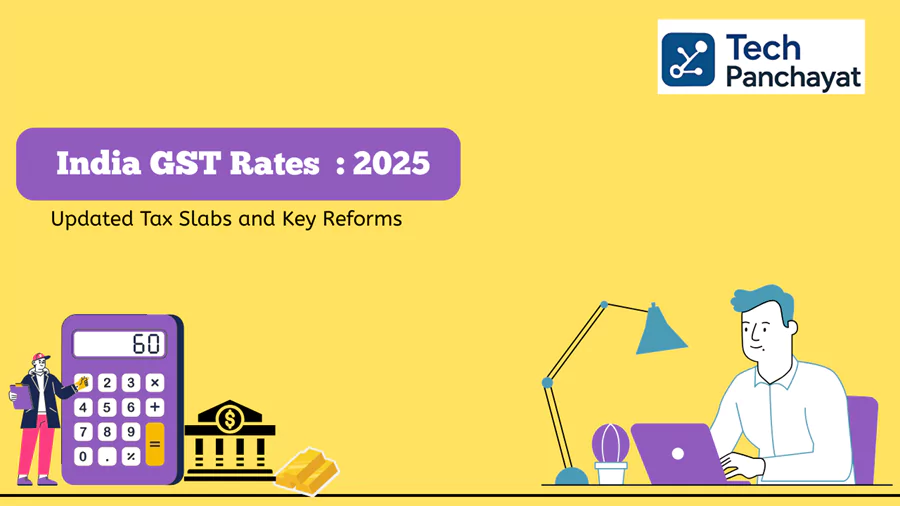GST stands for Goods and Services Tax. It is a unified indirect tax imposed on the supply of goods and services across India. The key objective of GST is to eliminate the cascading effect of multiple taxes, promote a common national market, and make tax compliance easier for businesses. GST is a major indirect tax in India, introduced in 2017 to simplify the taxation structure by replacing multiple indirect taxes. In 2025, the Indian government implemented significant reforms in the GST system, aiming to simplify tax compliance and make it more consumer-friendly. These reforms introduced new GST slabs, adjusted existing rates, and reclassified several goods and services. In this blog by TechPanchayat, we provide a detailed and updated guide to the latest GST rates applicable from September 22, 2025.
Why the GST Reforms
The 2025 GST reforms were introduced to address certain complexities in the existing system, reduce litigation, and make the tax structure more straightforward for consumers and businesses. By rationalizing the GST slabs and introducing a new high tax rate on luxury and sin goods, the government aims to promote affordability for essential items while discouraging the consumption of harmful products.
Updated GST Rate Structure
The revised GST rates will take effect from September 22, 2025, with no changes to the existing registration thresholds under the CGST Act.
| Category / Tax Slab | Applicability (Broad Categories) | Previous GST Rate | New GST Rate (2025) |
|---|---|---|---|
| 0% | Essential food items (fresh fruits, vegetables, unprocessed cereals), life-saving medicines, educational & basic healthcare services | 0% | 0% |
| 5% | Processed food items, household goods, FMCG products, packaged food, some healthcare services, public transportation, small restaurants | 5% | 5% |
| 12% | Certain textiles, processed food products, industrial inputs | 12% | 12% |
| 18% | Most goods and services (electronics, telecom services, branded garments, furniture) | 18% | 18% |
| 40% | Luxury and sin goods (tobacco products, pan masala, aerated drinks, high-end automobiles) | 28% (previous highest slab) | 40% |
Key Highlights of GST Reforms
The 2025 reforms to India’s Goods and Services Tax (GST) system mark a significant restructuring aimed at simplifying the tax structure, making essential goods more affordable, and increasing revenue through a higher levy on luxury and harmful products. The government has retained the 0% and 5% GST slabs for essential commodities, reaffirming its commitment to affordability and social equity.
Key Outcomes of 0% and 5% GST Slabs
| Key Outcome | Explanation |
|---|---|
| Maintains affordability for low and middle-income households | Ensures essentials remain accessible to everyone. |
| Helps curb inflation in essential goods | Keeps inflation in check for critical daily-use products. |
| Promotes access to basic healthcare and education | Reduces the cost barrier for essential health and education services. |
Standard Goods and Services: 12% and 18% Slabs
Most products and services now fall into either the 12% or 18% GST slab, providing a more stable and predictable structure.
- 12% Slab: Processed foods, some textiles and garments, footwear under a price threshold.
- 18% Slab: Consumer electronics, telecom services, branded apparel, industrial inputs.
Key Implications of 12% and 18% Slabs
| Key Implication | Explanation |
|---|---|
| Balances consumer affordability and revenue collection | Ensures tax rates are sustainable and fair. |
| Supports manufacturing and services growth | Promotes business investment and industry expansion. |
| Clarifies classification of goods and services | Reduces confusion and litigation for businesses during tax filing. |
New 40% GST Slab for Luxury and Sin Goods
One of the most significant reforms is the introduction of a new 40% GST slab, replacing the earlier highest slab of 28%, targeting goods considered luxurious or harmful.
Covered Items:
- Tobacco products
- Pan masala and gutka
- Aerated and sugary drinks
- High-end luxury cars and SUVs
- Luxury yachts and private jets
- Firecrackers and similar high-pollution items
Key Implications of the 40% GST Slab
| Key Implication | Explanation |
|---|---|
| Discouragement of harmful consumption | Higher tax on tobacco and sugary drinks aims to reduce health risks. |
| Promotes environmental sustainability | Heavy tax on firecrackers and polluting luxury vehicles supports green goals. |
| Aligns with luxury tax principle | High-income individuals still access luxury goods but contribute more tax. |
| Generates additional government revenue | Simplifies tax structure and improves revenue from luxury goods. |
Impact of GST Reforms on Consumers and Businesses
- For Consumers: The revised structure is designed to lower the cost of essential items while increasing the tax burden on luxury and harmful products. This makes daily essentials more affordable, improving the cost of living for average consumers.
- For Businesses: The new tax slabs simplify the GST filing process and reduce ambiguities around classification of products. However, businesses dealing in luxury goods and sin products will now face a higher tax rate, impacting their pricing strategy.
For more articles and updates related to business, finance, and taxation reforms, visit TechPanchayat – your trusted source for the latest industry insights.
How to Stay Updated with GST Rates
Conclusion
The 2025 GST reforms mark a significant step towards simplifying India’s taxation system. By reducing rates on essentials and increasing the tax on luxury and sin goods, the government aims to promote consumer welfare and discourage unhealthy consumption. Whether you are a consumer, business owner, or tax professional, understanding these new GST rates is essential for compliance and better financial planning.
For the latest business, tax, and finance news, insights, and updates, stay connected with TechPanchayat.

